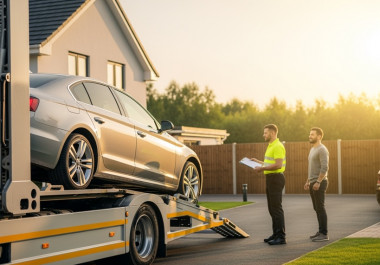Fleet vehicle liquidation may seem complex, but many companies have discovered it to be a straightforward and profitable method for disposing of surplus or ageing vehicles. This approach is particularly common among government departments, large corporates, and businesses managing seized vehicles. Through fleet vehicle auctions, companies can quickly convert depreciating assets into liquid funds while maintaining transparency and efficiency throughout the process.
A Fresh Perspective on Fleet Liquidation
When companies require fleet updates or need to dispose of vehicles that have outlived their prime, the auction process becomes an ideal solution. Auctions offer an open arena where competitive bids often drive up the final sale price, reflecting the true market value of the vehicles. This method is particularly effective during fleet liquidation sales, a strategy employed during corporate fleet downsizing to eliminate surplus assets and reinvest in modern, efficient models. Whether dealing with commercial fleet vehicles or exploring military surplus vehicle auctions, the auction format provides a transparent and efficient liquidation pathway.
Understanding the Fleet Liquidation Process
The Rationale Behind Auction Liquidations
Fleet vehicles represent a substantial investment. Over time, factors such as depreciation, ongoing maintenance costs, and technological advancements mean that older vehicles no longer meet operational needs. Rather than holding onto these depreciating assets, companies choose to auction them to recover value. This process not only restores a portion of the original investment but also facilitates corporate fleet downsizing by converting excess vehicles into valuable capital.
Key benefits of choosing auctions include:
Speed of Sale: The auction format accelerates the sale of multiple vehicles simultaneously, reducing idle time between fleet updates.
Competitive Bidding: A dynamic bidding environment ensures that prices reflect current market realities.
Transparency: Detailed inspections and clear procedures provide confidence in every transaction.
Market Value Discovery: Auctions reveal up-to-date market trends, enabling accurate pricing that attracts competitive bids.
The Auction Environment in Detail
Specialised auction houses oversee the entire process, from thorough vehicle inspections and comprehensive marketing to seamless on-site or online bidding. Buyers appreciate the clear vehicle descriptions, precise odometer readings, and detailed maintenance records, all of which minimise uncertainty when purchasing used fleet vehicles.
The Role of Fleet, Government, and Seized Vehicle Auctions
Diverse Categories Under One Umbrella
Fleet auctions cover a broad spectrum of vehicles, ranging from saloons and hatchbacks to vans and lorries. Government and seized vehicle auctions, in particular, often involve vehicles tied to larger procurement programmes or recovered through legal processes. In every case, the auction mechanism provides clarity on vehicle history and condition, supporting informed decision-making.
Government Auctions: Often include vehicles from local councils, public sector agencies, or emergency services. These vehicles tend to be maintained to rigorous standards. Buyers can browse vehicle auctions to find government fleet offerings alongside surplus defence vehicle listings from various public sector organisations.
Fleet Auctions: Large companies, such as car rental services or logistics firms, upgrade their fleets periodically. The vehicles presented come with full service records, ensuring buyers understand exactly what they are acquiring. Those interested in passenger vehicles can explore car auction listings featuring diverse fleet liquidation opportunities.
Seized Vehicle Auctions: These auctions, conducted under strict regulatory oversight, feature vehicles that have been repossessed or recovered. Detailed documentation accompanies each vehicle to reduce risks for buyers.
Military Surplus Vehicle Auctions: Defence organisations periodically release vehicles that have completed their service lifecycle. These military surplus vehicle auctions often feature robust, well-maintained vehicles including land rovers, lorries, and specialised equipment. Surplus defence vehicle listings typically provide comprehensive maintenance histories and detailed specifications to assist potential buyers in making informed decisions.
The Auction Journey: A Step-by-Step Overview
Preparation and Listing
Before a fleet reaches the auction block, companies conduct thorough assessments to decide which vehicles to liquidate, considering mileage, condition, and market demand. Each vehicle undergoes detailed inspections, and robust reports are compiled. High-resolution images and comprehensive descriptions build buyer trust and ensure that listings are competitively presented.
Important elements of a quality listing include:
-
Complete maintenance and service records
-
Documentation of any modifications or upgrades
-
Detailed vehicle history, noting any past incidents or repairs
-
Clear information on mileage and usage
Auction Day: Live Bidding and Digital Platforms
Many auction houses enable both on-site and online bidding, extending their reach and enhancing competitive participation. During live bidding, potential buyers can assess real-time progress and place informed bids based on thorough vehicle details. Support channels address any queries promptly, ensuring fairness and transparency throughout the auction process. Platforms like RAW2K have revolutionised how buyers access fleet liquidation sales and military surplus vehicle auctions through intuitive digital interfaces.
Post-Auction Procedures: Finalising the Sale
Following the auction, the winning bid proceeds to the finalisation phase, where payment processes and vehicle transfers are completed with standardised legal and financial documentation. Some auction houses further assist with logistics such as vehicle transportation and the requisite transfer paperwork.
Integrating Technology for a Modern Auction Experience
Recent advances in technology have redefined the auction landscape. Modern digital platforms offer sophisticated search filters, virtual tours, and real-time bidding systems, all designed to ensure a seamless experience regardless of geographical location.
Key platform features include:
Intuitive Website Navigation: Easily explore listings and engage with auctions via an accessible online interface.
Regional Sorting: Dedicated regional pages, such as South East, North East, North West, Wales, West Midlands, Northern Ireland, and Scotland, ensure local buyers find relevant opportunities.
Secure Transactions: Robust security measures protect both bidding and payment processes.
Responsive Support: For any questions during the process, customer assistance is readily available.
Business Cases and Practical Anecdotes
Consider a scenario where a local government body needed to update its fleet promptly. Rather than enduring a lengthy traditional sales process, they opted for an auction, aligning with their corporate fleet downsizing strategy. This efficient method allowed for swift disposal of surplus vehicles and enabled reinvestment in newer, environmentally compliant models.
In another case, a national delivery service systematically retired vehicles upon reaching a certain mileage. Auctioning these vehicles not only recovered valuable funds but also eliminated the ongoing administrative burden. One business owner remarked, "The comprehensive vehicle histories and clear images provided during the auction instilled great confidence in the bidding process."
Balancing Asset Value with Business Strategy
Strategic fleet liquidation is not merely about selling vehicles; it's about maintaining fiscal agility. Auctions provide companies an avenue to free up cash, which can then support investments in technology or facilitate further expansion. This process is particularly beneficial when orchestrating corporate fleet downsizing, ensuring that surplus vehicles contribute to future growth.
Timing Is Key
Determining the optimal moment to liquidate fleet vehicles at auction requires both art and science. Auction houses often schedule sales during favourable market conditions, ensuring competitive pricing that can be reinvested into cutting-edge assets. Understanding seasonal demand patterns for surplus defence vehicle listings and military surplus vehicle auctions helps companies maximise returns.
Realistic Price Expectations
Even with an attractive auction setup, realistic pricing is essential. Vehicles with robust maintenance records are likely to fetch impressive bids, while older or higher-mileage vehicles may require more competitive offers. Expert appraisals and detailed market research help in setting fair starting prices.
The Crucial Role of Expert Valuation and Transparency
Transparency is central to any successful auction. Full insights into a vehicle's condition and history encourage informed bidding and build lasting trust. Expert valuation covers several critical areas, including:
Mechanical Health: Ongoing maintenance and service records confirm a vehicle's sound condition.
Market Trends: Current market data guide competitive pricing strategies.
Legal and Compliance Matters: Particularly important for seized vehicles, ensuring all legal documentation is in order.
Future Potential: Even older vehicles may attract niche markets if presented accurately.
Tips for Companies Considering Auction Liquidation
A robust strategy is crucial for companies planning to liquidate their fleet vehicles through auction. Consider the following steps:
Conduct a Thorough Inventory Assessment: Evaluate the condition, mileage, and service history of each vehicle to decide which ones to list.
Leverage Expert Valuations: Engage industry specialists to establish fair market values, ensuring competitive bidding during fleet liquidation sales.
Ensure Transparency: Make all necessary documentation, including maintenance and legal records, readily available to build buyer confidence.
Target the Right Buyers: Align your auction strategy to attract knowledgeable buyers experienced with fleet, government, or seized vehicle auctions.
Plan for Post-Auction Logistics: Organise essential steps for payment processing and vehicle transfer to prevent unnecessary delays.
RAW2K: A Leader in Vehicle Auction Solutions
Many companies have chosen dedicated auction platforms for their fleet liquidation needs. With tailored solutions addressing government fleet management, corporate asset liquidation, and seized vehicle auctions, comprehensive platforms ensure every listing is detailed and accessible. Fleet operators disposing of two-wheeled vehicles can explore motorcycle auction listings alongside traditional passenger vehicles, whilst those managing recreational fleets can access caravan auction opportunities for holiday vehicle liquidation.
Key strengths include:
Tailored Sector Solutions: Whether managing government fleets, corporate assets, or seized vehicles, platforms are designed to meet diverse requirements.
Regional Connectivity: Regional pages, such as those for North East, North West, and Scotland, enable direct access to locally relevant listings.
Responsive Customer Support: For any enquiries during the auction process, assistance is provided through dedicated support channels.
Secure, User-Friendly Interface: Platforms guarantee robust security and ease of use throughout the auction journey.
Drawing from Practical Experience
One notable example involved a major logistics company that initiated corporate fleet downsizing through an auction. Each vehicle's comprehensive history and high-quality images instilled trust among bidders, resulting in a smooth and transparent process. This case clearly illustrates how a well-prepared auction strategy can overcome traditional sales challenges and unlock hidden asset value.
Similarly, defence organisations conducting military surplus vehicle auctions have found that detailed surplus defence vehicle listings with transparent maintenance histories attract serious buyers and achieve competitive pricing outcomes.
The Human Element in Fleet Liquidation
Auctioning fleet vehicles goes beyond numbers - it builds lasting relationships founded on trust and transparency. Such genuine connections can lead to repeat business and future collaborative opportunities. One fleet manager noted that each auction not only completed a transaction but also paved the way for ongoing, mutually beneficial partnerships.
Building a Winning Auction Strategy
For companies ready to liquidate fleet vehicles through auction, a few strategic considerations can enhance success:
Conduct Extensive Market Research: Understanding current trends and historical auction data informs realistic pricing and competitive reserve setting.
Develop Effective Marketing Assets: Create high-quality listings featuring transparent vehicle histories and detailed specifications to attract the ideal buyer.
Choose Flexible Auction Formats: Decide between live and online bidding based on your company's needs, with online auctions offering broad reach and convenience. Those interested in participating can register to bid on upcoming fleet liquidation sales across various vehicle categories.
Maintain Post-Auction Engagement: Continuously communicate with buyers to ensure seamless post-auction transitions and foster long-term credibility.
Looking Ahead: Future Trends in Fleet Liquidation Auctions
Emerging technologies continue to reshape the auction landscape. Innovations like virtual tours, augmented reality inspections, and AI-driven market analyses are enhancing efficiency and transparency in fleet liquidation. The ongoing evolution of digital platforms is set to benefit everyone from sellers to buyers, positioning auctions as a long-term solution for modern asset management. These technological advances apply equally to commercial fleet sales and military surplus vehicle auctions, creating more accessible marketplaces.
Concluding Thoughts: Unlocking Value Through Strategic Auctioning
Liquidating fleet vehicles through auction offers a clear, transparent method to unlock value from ageing or surplus assets. Whether managing government fleets, corporate assets, seized vehicles, or exploring military surplus vehicle auctions, the auction process provides efficiency, market insight, and competitive outcomes - all of which support broader corporate fleet downsizing objectives.
For additional details on current auction opportunities and expert guidance on fleet liquidation, explore comprehensive auction platforms. Those seeking specific information about surplus defence vehicle listings or general auction enquiries can contact us for personalised support.
Embracing a modern auction experience means transforming surplus assets into strategic capital, freeing up resources for future growth. With dedicated platforms leading the way, the path to efficient fleet liquidation is both transparent and rewarding.
Happy bidding, and may your next auction unlock the value your business deserves.




